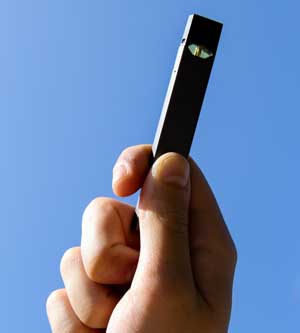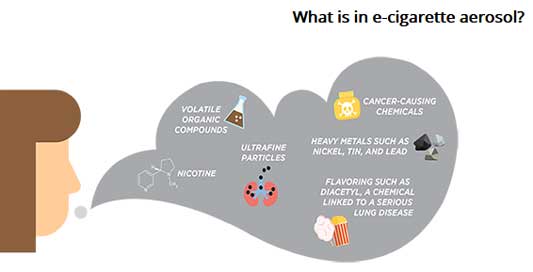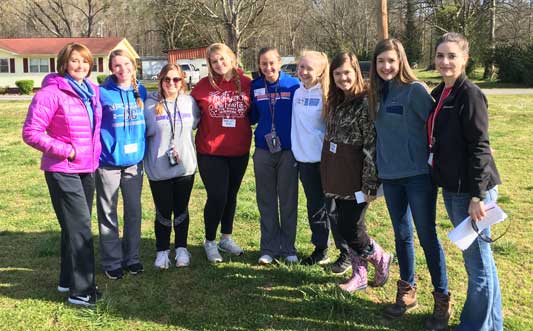Jun 03, 2020
Drug Education and Cessation Programs Help Teens Avoid or Quit Vaping
by Allee Mead
 Tristi Bond,
former health educator for Tennessee's rural Marion and
Sequatchie counties, realized that vaping was a problem
in her community when a number of vape shops opened up.
The proximity and volume of shops made it easier for
adults and even teenagers to start vaping and cause
damage to their lungs. Even worse, a school administrator
told her that children as young as 5th grade
had been caught vaping.
Tristi Bond,
former health educator for Tennessee's rural Marion and
Sequatchie counties, realized that vaping was a problem
in her community when a number of vape shops opened up.
The proximity and volume of shops made it easier for
adults and even teenagers to start vaping and cause
damage to their lungs. Even worse, a school administrator
told her that children as young as 5th grade
had been caught vaping.
From 2018 to 2019, Bond worked with school health coordinators in each county to give presentations about the dangers of vaping to middle and high school students. In that time, she reached about 1,650 students. With each presentation, Bond would co-present with student volunteers. "I explained what vapes are, what chemicals you find in them, how Big Tobacco profits off hooking youth, what nicotine is and why it's bad for adolescents, tips to help break the cycle of addiction, and Tennessee Tobacco QuitLine information," she said.
The second half of the presentation was given by Tennessee Teens Talk Tobacco (T4) students, who had visual aids like a jar of phlegm and healthy/unhealthy pig lungs to show attendees what tobacco does to the body. Bond remembers the students' reactions during the pig lung presentation. "They're just very engrossed in what the T4 student was talking to them about. All eyes were on her," Bond said.
According to the National Institute on Drug Abuse (NIDA), vaping devices, also called e-cigarettes or electronic nicotine delivery systems, are often made up of a cartridge holding a liquid solution, an atomizer, a power source, and a mouthpiece. The atomizer heats up the liquid, which almost always contains the addictive chemical nicotine, and the user inhales the aerosol.

While e-cigarette companies have marketed their products as a way for adults to quit smoking, in recent years many adolescents have been introduced to nicotine through e-cigarettes. In fact, research shows that teenagers who reported trying e-cigarettes were more likely than non-users to later report trying traditional cigarettes.
Some e-cigarettes contain higher levels of nicotine than traditional cigarettes, and e-cigarettes that use nicotine salts deliver high levels of nicotine more quickly than other tobacco products. Nicotine is especially harmful to teenagers and young adults, since their brains haven't fully developed yet.
Thomas Ylioja, PhD, MSW, Clinical Director of Health Initiatives at National Jewish Health, said, "What we're seeing now with vaping is that a lot of young people are looking for help and they just have so much higher nicotine dependence, so much stronger addiction to nicotine compared to when they were smoking."
He added, "They experience very powerful nicotine withdrawal symptoms, often leaving school early with headaches and feeling nauseous. They are having difficulty concentrating on their schoolwork and are thinking about how to get more nicotine when they are playing sports or trying to study. They don't want their parents to know, so they suffer in secret."
So how many teens are vaping? The NIDA Monitoring the Future survey from 2019 [no longer available online], with responses from 42,531 students (8th, 10th, and 12th grade) across the country, shows that 25.5% of 12th graders reported vaping nicotine in the past month, and 11.7% of this grade reported vaping nicotine every day. For 10th graders, 19.9% reported vaping nicotine in the past month, while 6.9% reported vaping nicotine every day. For 8th graders, 9.6% reported nicotine vaping in the past month, with 1.9% reporting nicotine vaping every day.
While the majority of teenagers do not vape, groups across the country are working to reduce the numbers of those who do and to prevent other teens from starting.
Providing Education, Not Lectures
Bond said some students challenged the information she presented, so she would present research that disputed the student's claim or, if a particular claim seemed plausible, thank the student for letting her know and telling them she'd look into it. Sometimes these conversations led Bond to adding new information to her presentation. This approach let students know they were heard.
Students reached out for advice, help, and resources for themselves, their family members, and/or their friends. I really appreciated students being vulnerable with me and trusting me with the information they shared.
The presentations also had a question-and-answer session, but Bond said the one-on-one conversations she had with students after the presentations were more fruitful. "Students reached out for advice, help, and resources for themselves, their family members, and/or their friends. I really appreciated students being vulnerable with me and trusting me with the information they shared," she said.
In California, Dawn Charlton is a youth educator for Being Adept, a drug education program. While she lives and works in San Francisco, Charlton travels to rural Point Reyes Station and Tomales to present Being Adept to West Marin Elementary School's 6th grade class and Tomales Elementary School's 8th grade class, respectively.
Christina Hetzer is the Prevention and Early Intervention (PEI) school-based counselor at Shoreline Unified School District and is primarily based at West Marin. She said middle school students in this district have been caught with vaping devices and have been found vaping in bathrooms and on campus after school hours.
Unlike drug education models of the past, which tended to rely on scare tactics, Being Adept teaches 5th-8th grade students what drugs do to the brain and other parts of the body and helps them make decisions that feel right for them.
Being Adept Curriculum
Being Adept's curriculum offers eight lessons (no longer available online):
- Alcohol
- Nicotine & E-Cigarettes
- Marijuana
- Stimulants
- Rx Drugs & Opioids
- Media Literacy (glamorization of substance use, companies' marketing strategies)
- Stress Busters (healthy ways to reduce stress)
- Pressure & Decisions (different types of peer pressure, defining personal values)
The Nicotine & E-Cigarettes lesson covers the following topics:
- "Statistics of teen e-cigarette use"
- "The difference between a vapor and aerosol"
- "The potentially harmful and harmful chemicals found in e-cig 'juice'"
- "The concept of third-hand smoke"
- "How and why companies market their products to kids"
- "How nicotine impacts the cardiovascular and the brain's reward systems"
Charlton said Being Adept helps students reconcile the
science of how drugs harm the body with some students'
experiences of seeing family members smoke, drink, or use
other substances. In addition, a number of these
community members work in the wine or cannabis industry.
She tells students that "the effects are gradual and hard
to notice, the effects are unpredictable and very
different for different individuals, and addiction is
still very stigmatized, so people don't talk openly about
their struggles."

Charlton also discusses the short-term and long-term effects of nicotine on the lungs as well as the heart and brain. "You cannot just assume that these youngsters have the same information I did about the dangers of traditional cigarettes," she said. "The public awareness work around the dangers of smoking traditional cigarettes was so ubiquitous my whole life up until about 10 years ago, when I think the numbers really did start to get lower and we just assumed everybody knew." She also compares the aerosol from vaping products to California's recent wildfires, since both produce particles that are harmful to people's lungs.
Charlton also uses surveys like the California Healthy Kids Survey and the NIDA Monitoring the Future survey to show students that the number of teenagers actually using different substances is often lower than these students may think.
At any given moment the more popular choice is actually not using and, if you choose not to use, you're definitely not alone.
Charlton tells students, "At any given moment the more popular choice is actually not using and, if you choose not to use, you're definitely not alone."
Reaching Teens
In Colorado, Ylioja and his National Jewish Health colleagues found that not many teenagers were using the National Cancer Institute's 1-800-QUIT-NOW to quit nicotine products, including vaping — despite an uptick in the number of teenagers using e-cigarettes. He and his colleagues wanted to better understand how they could serve teenagers looking to quit tobacco.
Through focus groups and interviews in the spring of 2019, Ylioja and his colleagues learned that teenagers knew about the quit line but thought it was for adults only. He added that the focus group "wanted a program that they knew was designed for young people. They really wanted to know that it would address vaping, that they wouldn't be talked down to, that they wouldn't be getting a parent or a teacher on the phone, they wanted it to be confidential, that we would not release their information."
With this input, National Jewish Health launched the My Life, My Quit program in July 2019, complete with an online chat option and a text message option. "It was really key that we had a program that was clearly designed for teens with input from teens," Ylioja said.
My Life, My Quit serves rural and urban teens from 18 states: Colorado, Idaho, Iowa, Kansas, Kentucky, Massachusetts, Michigan, Minnesota, Montana, Nevada, New Hampshire, North Dakota, Ohio, Oklahoma, Pennsylvania, Rhode Island, Utah, and Wyoming. When the program receives calls from people outside these states, these callers are referred to 1-800-QUIT-NOW, the Truth Initiative's This Is Quitting text messaging program, or any local resources.

Other Programs to Help Teens Quit
This Is Quitting
The Truth Initiative's This Is
Quitting is a free, anonymous program to help young
people (about 13 to 24 years old) quit vaping. Those
who want to enroll can text DITCHVAPE to 88709.
Enrollees can set their own quit date and receive one
text message per day, and they can text COPE, STRESS,
SLIP, or MORE for on-demand support.
Parents can text QUIT to 202.899.7550 for support in helping their children quit vaping.
Not On Tobacco
Not On Tobacco® (N-O-T): This American Lung
Association program provides ten 50-minute sessions for
participants aged 14 to 19. Facilitators receive seven
hours of training and then can teach the curriculum in
a school or community setting.
Smokefree Teen
Smokefree Teen, a National Cancer Institute
program, offers the SmokefreeTXT texting program (text
QUIT to 47848); the quitSTART app; live online chat
with a trained counselor; and blog posts about vaping
triggers, cravings, and withdrawal symptoms.
My Life, My Quit sessions with a tobacco/vaping cessation
coach are free and confidential. Through five coaching
sessions, trained coaches help participants set up a quit
plan, identify and find a way to deal with their triggers
to smoke or vape, and determine behaviors that will help
them manage cravings and withdrawal symptoms.
Rural residents face barriers to access tobacco cessation services, such as travel, cost, or lack of in-person services in the area. For rural teens trying to quit, a program like My Life, My Quit allows them to talk with a cessation coach without having to travel to a doctor's office. Teens schedule appointments that fit their schedule.
"One of the nice things about quit lines generally and the My Life, My Quit program as well is that they're highly accessible, as long as you have access to a smartphone or any phone, really, or if you have access to the internet," Ylioja said.
Like the My Life, My Quit program, Being Adept values teens' input. Charlton has the students brainstorm why teens vape. The brainstorming and discussions teach her what students already know and help her adjust presentations accordingly. While drug education models usually focus on peer pressure and a desire to fit in, students often bring up stress and depression as reasons teens use. She also has students brainstorm healthy ways to manage their stress.
The lessons are designed so that Charlton can visit the same group of students more than once and talk about different topics. Multiple visits help her build a rapport with students and reinforce what they learned during previous lessons. Students have told Hetzer, the PEI counselor, that the Being Adept lessons are helpful. The 8th graders told her they especially benefited from the stress management lessons, while the 6th graders seemed interested in all the topics, as the information presented was new to them.
Tennessee encourages student engagement through its Tennessee Teens Talk Tobacco (T4) group, in which middle and high school students host events for their classmates. Along with attending the annual TNSTRONG Youth Summit, Marion County's T4 group volunteered at Healthy Horizons, a day-long event for 4th graders to learn about tobacco, nutrition, and exercise.
Bond and the T4 students also celebrated Tennessee Quit Week in February and Kick Butts Day (now called Take Down Tobacco) in March. For Kick Butts Day, Marion County held a Breathe Easy Track Meet, which included different events for middle school students like Get Rid of that Cigarette as Fast as You Can! Team Dynamics Relay, Breathe Through a Straw, and Crush Big Tobacco – Knock Down Tobacco Ads. Bond said students seemed to most enjoy knocking down vaping and cigarette ads.
The Breathe Easy Track Meet won a Primary Prevention Bright Spot Award from the Tennessee Department of Health, and the Sequatchie County Health Department was featured as a NACCHO success story in a July 2019 National Association of County & City Health Officials publication.
Helping Parents and Communities
T4 students presented at the Marion County school board meeting to advocate for vaping policy changes. Previously, students who were caught vaping were sent to alternative school, which was ineffective in changing students' behavior. Bond and T4 students felt that a Saturday School, which both the student and parents/guardians had to attend, would work better. The T4 students created a presentation and delivered it to the Marion County Board of Education, who approved the Saturday School plan. Bond received a Sequachee Valley Electric Cooperative grant to fund the pilot program.

Ylioja from My Life, My Quit said he has early data showing quit rates above 40% three months after program enrollment. He has also studied how people learn about My Life, My Quit. About a third learn about the program online, through an ad or social media. Another third learn through traditional methods like TV or radio ads, flyers, and event booths. The rest were referred to the program through their school.
Schools are really vital to the solution of youth vaping because they just interact with young people so much that they can just deliver the message about the potential harms of vaping to young people. They can also talk to them about resources that are available to help them quit.
"Schools are really vital to the solution of youth vaping because they just interact with young people so much that they can just deliver the message about the potential harms of vaping to young people," Ylioja said. "They can also talk to them about resources that are available to help them quit."
Ylioja and his colleagues also work with the department of health in each state of its service area to promote My Life, My Quit. National Jewish Health provides promotional materials and encourages the departments of health to partner with schools and healthcare providers.
In California, Being Adept parent nights allow families to come to the school and ask questions about teen substance use and effective ways to talk to their children. A panel of local high school students share their experiences, and families leave with a handout of tips and resources, including how to help teenagers quit tobacco products. Charlton said that some of her attendees at past parent events in West Marin and Tomales were primarily Spanish speakers, so she worked with an interpreter to translate parents' questions and her answers.
A teen board also makes videos for the youth educators to share with students and works with youth educators to share their experiences, recent trends in teen substance use, and teen slang. On one parent night panel, a high school senior said about vaping, "It's not cool anymore. It's just sad," and Charlton added that quote to her presentation for middle school students. Every year, Being Adept uses student input and the latest research to update materials.
Communities and schools interested in implementing Being Adept can purchase the online curriculum (no longer available online), which includes training materials and lesson plans. People interested in becoming a youth educator complete a training program included with the curriculum package to learn about motivational interviewing and substance use research and prevention. Charlton said youth educators can be a college student, a community member in recovery, or a parent or teacher.
Bond in Tennessee advised partnering with schools, community members, health coalitions/councils, and other key stakeholders instead of trying to go it alone. She also recommended being flexible when working with schools: "School systems are limited in the time they can allot for these efforts, so being able to work with them on their timeline and within their schedule is of paramount importance."
Resource for Healthcare Providers
- E-cigarettes and Youth: What Health Care Providers Need to Know, Centers for Disease Control and Prevention (CDC) publication


